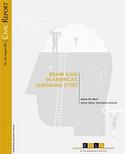John Austin at the Michigan Economic Center is a long time commentator on Midwest economic issues, going back to at least his 2006 Brookings Institute report “The Vital Center.” read more »
Cleveland
Of Niche Markets and Broad Markets: Commuting in the US
The six transit legacy cities - mostly urban cores that grew largely before the advent of the automobile - increased their concentration of transit work trips to 57.9% of the national transit commuting, according to the 2018 American Community Survey. At the same time, working at home strengthened its position as the nation’s third leading mode of work access, with transit falling to fourth. The transit commuting market share dropped from 5.0% in 2017 to 4.9% in 2018. read more »
- Login to post comments
Cleveland and the Fight for Talent
Mark Rantala recently wrote an op-ed for Crain’s Cleveland Business that talks about Cleveland’s need for talent: read more »
- Login to post comments
Lessons from the Oakland/San Francisco Dismissal
Federal District Court Judge William Alsup dismissed the "global warming" lawsuits of the cities of Oakland and San Francisco against large oil and gas companies, In so doing, the Judge provided important lessons in history, logic and public policy. read more »
- Login to post comments
Changing the Narrative in Cleveland
Cleveland, like many Rust Belt cities, has both an image and a self-image problem. Its residents have simultaneously had passion and loyalty for the city, while also being filled with shame about it and relentlessly negative and fatalistic about its future. Again, this is something that is the case for any number of places. read more »
- Login to post comments
Cleveland Renaissance Fair
So much talk of the Cleveland comeback with our downtown building boom and Republican National Convention-fueled makeover makes it difficult not to think about our mid-1990s civic renaissance. In 1995, The New York Times headline proclaimed " 'Mistake by the Lake' Wakes Up, Roaring" as downtown's stadiums and lakefront development created a "new face and new style of a city that for a long time had little panache."
But it wasn't just the media who became enchanted with our freshly minted charms — even the scholars were feeling it. The academics, however, had a Lake Erie-sized caveat. There was a divide in the region's comeback, noted the authors of the 1997 study "The Rise and Fall and Rise of Cleveland," with areas separated by characteristics of "capital investment and disinvestment, industrialization and deindustrialization, suburbanization and ghettoization, white flight and a black underclass, the growth of services, and a [high-skill and low-skill] dual economy." read more »
- Login to post comments
America’s Shrinking Cities Are Gaining Brains
If there’s one thing that’s a nearly universal anxiety among cities, it’s brain drain, or the loss of educated residents to other places. I’ve written about this many times over the years, critiquing the way it is normally conceived.
Since brain drain seems to be a major concern in shrinking cities, I decided to take a look at the facts around brains in those places. Looking at the 28 metro areas among the 100 largest that had objective measures of shrinkage – in population and/or jobs – between 2000 and 2013, I looked what what happened to their educational attainment levels. read more »
- Login to post comments
The New, Improved? Rust Belt
There is no longer a Rust Belt. It melted into air. The decline of manufacturing, the vacancy of the immense, industrial structures that once defined the productive capacities and vibrant lives of so many pockmarked towns, the dwindling of social capital—all the prognosticators writing the obituaries for these dead geographies were right.
How long were rust belt cities going to be able to, as author Robert Putnam would phrase it, “bowl alone?" It turns out not very long. read more »
- Login to post comments
The Rustbelt Roars Back From the Dead
Urban America is often portrayed as a tale of two kinds of places, those that “have it” and those who do not. For the most part, the cities of the Midwest—with the exception of Chicago and Minneapolis—have been consigned to the second, and inferior, class. Cleveland, Buffalo, Detroit or a host of smaller cities are rarely assessed, except as objects of pity whose only hope is to find a way, through new urbanist alchemy, to mimic the urban patterns of “superstar cities” like New York, San Francisco, Boston, or Portland. read more »
Brain Drain Hysteria Breeds Bad Policy
Desperate times call for desperate measures. The Rust Belt, a region familiar to the air of anxiety, knows this all too well, particularly the “desperate measures” part.
A case in point: During the 1990’s, Pittsburgh, like many of its Rust Belt peers, was in the midst of a fit of brain drain hysteria. Strategic policy was needed. So the powers that be thought of a marketing campaign meant to saturate the minds of the educated “young and the restless” who were thinking about exiting the Steel City. read more »
- Login to post comments




















